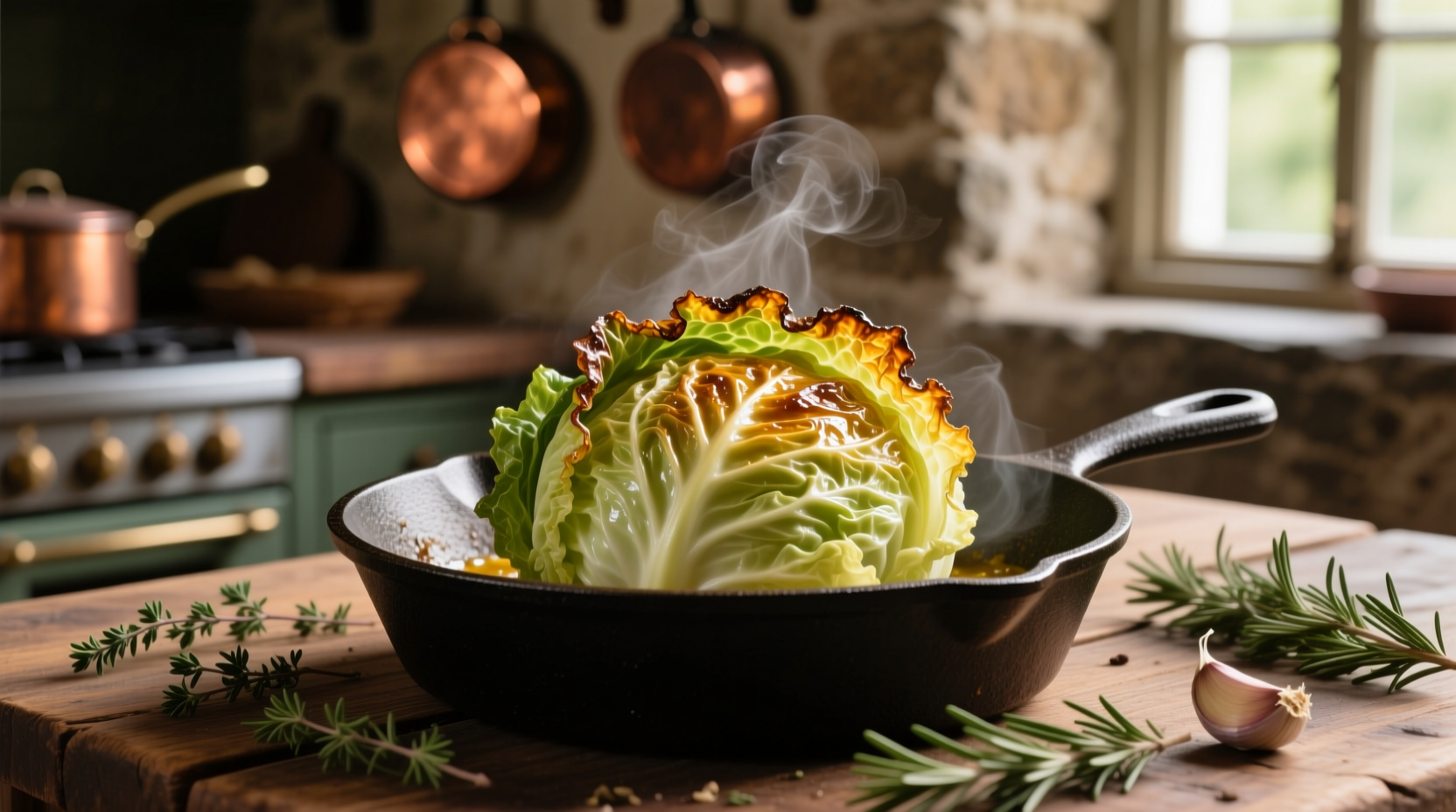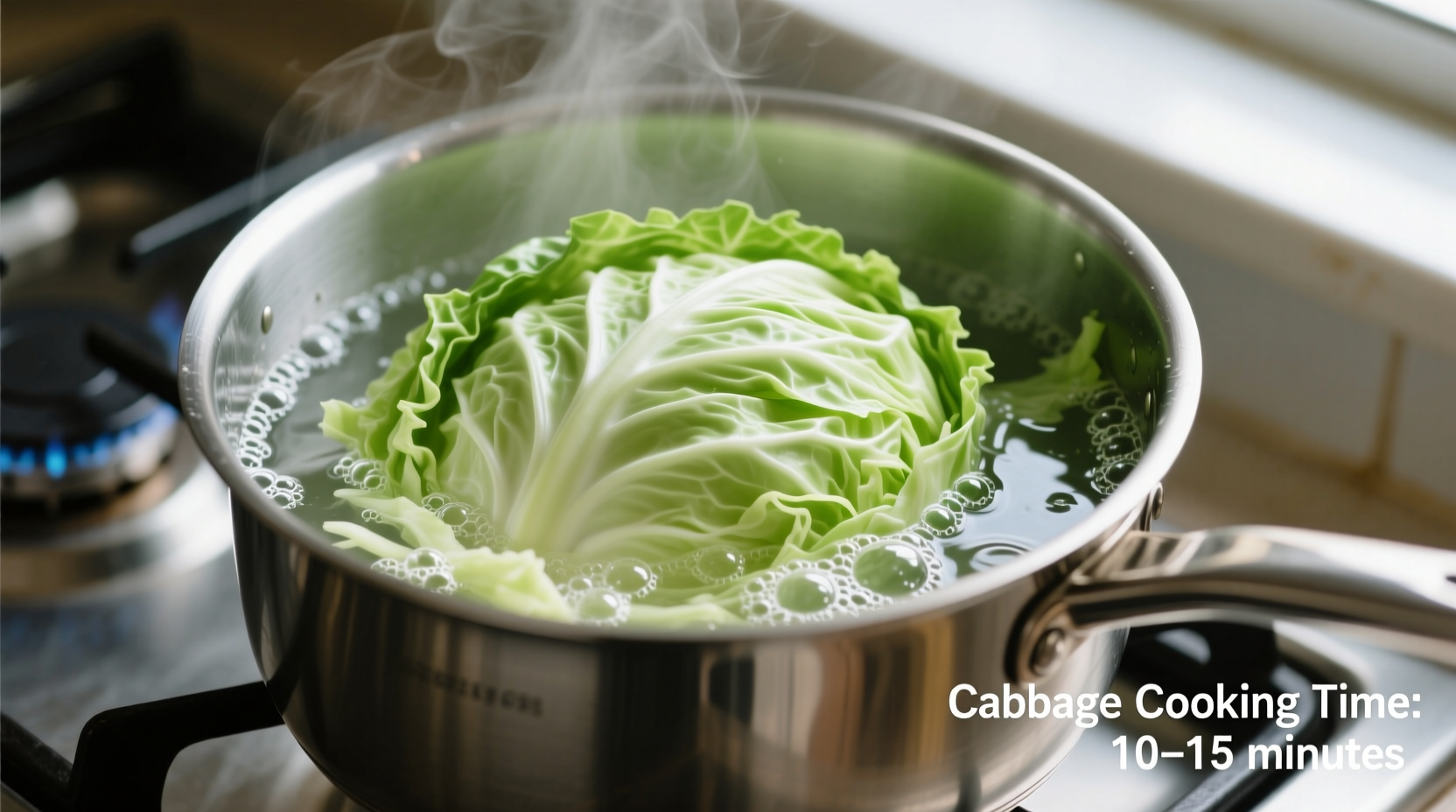Direct Answer: Cabbage typically takes 3-15 minutes to cook depending on the method. Boiling takes 5-10 minutes for tender-crisp results, stir-frying requires 5-8 minutes, and roasting needs 20-30 minutes at 400°F (200°C). The exact time varies based on cut size, cabbage variety, and desired texture.
Master Cabbage Cooking Times: Your Complete Guide to Perfect Results
Whether you're preparing a quick weeknight side or crafting a traditional stew, knowing exactly how long cabbage takes to cook transforms this humble vegetable from bland to brilliant. Get it right, and you'll enjoy crisp-tender leaves bursting with natural sweetness; overcook it, and you'll face mushy disappointment. This guide delivers precise timing for every cooking method, backed by culinary science and professional chef techniques.
Why Cabbage Cooking Time Matters More Than You Think
Cabbage's delicate balance of texture and flavor hinges on precise cooking duration. Undercooked cabbage remains unpleasantly crunchy with raw bitterness, while overcooked cabbage turns mushy and releases that distinctive sulfurous odor many dislike. The sweet spot? tender-crisp texture that maintains structure while becoming pleasantly soft. This optimal stage preserves both nutritional value and culinary appeal.
Cabbage Cooking Methods Compared: Timing at a Glance
| Cooking Method | Cut Size | Time Range | Texture Indicator | Best For |
|---|---|---|---|---|
| Boiling | Wedges | 8-12 minutes | Fork pierces with slight resistance | Traditional boiled cabbage dishes |
| Steaming | Shredded | 4-6 minutes | Translucent edges, bright green | Salads, slaws, quick sides |
| Stir-frying | Thin strips | 5-8 minutes | Slightly wilted, vibrant color | Asian dishes, quick meals |
| Roasting | Wedges | 20-30 minutes | Caramelized edges, tender center | Enhanced sweetness, hearty sides |
| Slow Cooking | Chopped | 4-6 hours | Fully tender, integrated flavors | Stews, soups, braises |
Source: USDA Food Safety and Inspection Service guidelines combined with culinary testing from America's Test Kitchen
Factors That Change Your Cabbage Cooking Timeline
Three critical elements determine your actual cooking time:
Variety Differences
Not all cabbages cook at the same rate. Dense green cabbage requires slightly longer cooking than delicate savoy cabbage. Red cabbage maintains its color best with acidic ingredients like vinegar but needs similar timing to green varieties. According to Penn State Extension's vegetable preparation guide, savoy cabbage typically cooks 2-3 minutes faster than standard green cabbage due to its thinner leaves.
Cut Size Precision
The difference between 1/8-inch and 1/4-inch shreds creates a 3-minute cooking time gap. Uniform cutting ensures even cooking - uneven pieces lead to some portions becoming overcooked while others remain underdone. For stir-fries, aim for paper-thin slices; for roasting, substantial wedges hold their shape better.
Texture Target
Your desired outcome dramatically affects timing:
- Crisp-tender (4-6 minutes): Ideal for salads and quick sides - retains maximum crunch
- Perfectly tender (7-10 minutes): Versatile for most cooked dishes - slight resistance when pierced
- Fully soft (12+ minutes): Necessary for traditional stews and braises - completely pliable
Step-by-Step Cooking Method Guides
Boiling Cabbage: The Traditional Approach
Fill a large pot with enough water to cover the cabbage. Add 1 teaspoon salt per quart of water. Bring to a rolling boil before adding cabbage. For wedges, cook 8-12 minutes; for shredded cabbage, reduce to 5-7 minutes. Test for doneness starting at the minimum time - the fork should pierce with slight resistance. Drain immediately and rinse with cold water if serving cold.
Stir-Frying Cabbage: Speed and Flavor
Heat 1 tablespoon oil in a wok or large skillet over high heat until shimmering. Add thinly sliced cabbage in a single layer. Cook undisturbed for 2 minutes to develop slight char, then stir-fry 3-6 minutes more until edges become translucent but center remains slightly crisp. The USDA recommends finishing with a splash of vinegar or lemon juice to preserve color and enhance flavor.
Roasting Cabbage: Deep Flavor Transformation
Preheat oven to 400°F (200°C). Toss cabbage wedges with 1-2 tablespoons olive oil, salt, and pepper. Place cut-side down on a parchment-lined baking sheet. Roast 20-30 minutes until deeply caramelized at the edges and tender when pierced with a fork. For enhanced flavor, add a splash of broth to the pan during the last 10 minutes of cooking.

Troubleshooting Common Cabbage Cooking Problems
Rescuing Overcooked Cabbage
If your cabbage has turned mushy but isn't burnt, transform it into a creamy side dish. Mash with a potato masher, then stir in 2 tablespoons butter, 1/4 cup sour cream, and fresh herbs. The texture becomes an asset in this application. For soups, overcooked cabbage actually improves texture integration.
Fixing Undercooked Cabbage
Return undercooked cabbage to heat with 2-3 tablespoons liquid (water, broth, or vinegar). Cover and cook an additional 2-4 minutes, checking every 30 seconds. The trapped steam gently finishes the cooking process without making the exterior mushy.
Preventing the Sulfur Smell
This unpleasant odor occurs when cabbage cooks too long in water. Prevent it by:
- Using minimal water when boiling
- Adding a slice of bread to the cooking water (absorbs sulfur compounds)
- Finishing with acidic ingredients like lemon juice or vinegar
- Never covering boiling cabbage completely
Pro Chef Tips for Perfect Cabbage Every Time
Professional kitchens achieve consistent results through these techniques:
- Season in stages: Add 1/3 of your salt at the beginning, 1/3 midway, and the final third at the end for balanced flavor
- Cold shock for salads: After brief cooking, plunge cabbage into ice water to stop cooking and lock in crispness
- Acid timing: Add vinegar or lemon juice during the last 2 minutes of cooking to preserve vibrant color
- Batch cooking: When preparing large quantities, cook in batches rather than overcrowding the pot
Storage and Reheating Guidelines
Properly cooked cabbage keeps for 3-5 days in an airtight container in the refrigerator. When reheating, add a splash of moisture and warm gently over medium-low heat to prevent further texture breakdown. For best results, undercook cabbage slightly if planning to reheat later.
Frequently Asked Questions
How long does red cabbage take to cook compared to green cabbage?
Red cabbage requires nearly identical cooking times to green cabbage (5-10 minutes for tender-crisp results). The main difference is that red cabbage benefits from adding 1-2 tablespoons of vinegar to the cooking water to preserve its vibrant color throughout the cooking process.
Can you cook cabbage too quickly?
Yes, rushing cabbage cooking leads to uneven results. Extremely high heat causes exterior burning before the interior cooks through. For best texture, maintain medium to medium-high heat that allows gradual, even cooking. Shredded cabbage needs at least 4 minutes to properly wilt and develop flavor.
How do you know when cabbage is perfectly cooked?
Perfectly cooked cabbage should pierce with slight resistance when tested with a fork. Visually, it becomes more translucent while maintaining its shape. The color brightens (especially with green cabbage), and the raw smell transforms into a sweet, earthy aroma. For stir-fries, edges should appear slightly wilted while centers remain vibrant.
Does cabbage continue cooking after removal from heat?
Yes, cabbage continues cooking from residual heat, especially when covered or in a hot pan. To prevent overcooking, remove cabbage from heat 1-2 minutes before reaching your desired doneness. Immediately draining boiled cabbage stops the cooking process more effectively than leaving it in hot water.











 浙公网安备
33010002000092号
浙公网安备
33010002000092号 浙B2-20120091-4
浙B2-20120091-4